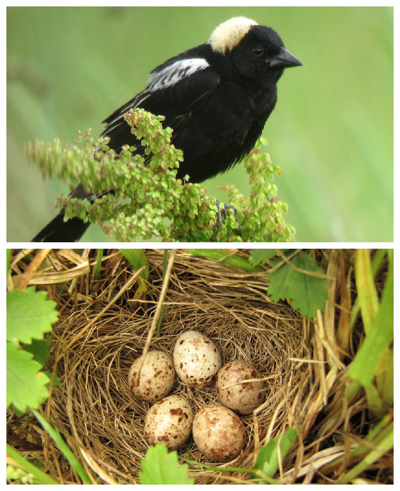Friends of Bobolinks is a project focused on the conservation of bobolinks and other wildlife that breed in hayfields and other suitable grassland habitats.
It is administered entirely by volunteers and is about to embark on Year 3 of the project.
In its first year (2013), Friends of Bobolinks concentrated on three towns — Morrisville, Stowe and Waterbury. In all, 272 fields were monitored; of those, 44 fields contained bobolinks. It is estimated that 1,000 acres of suitable habitat was saved through delayed mowing on those fields.
In Year 2, several towns in the area were added to the list. However, the combination of a long, dry summer (have tractor, will mow!) and personal difficulties experienced by some volunteers resulted in only a few extra hundred acres of successful (unmowed) breeding habitat.
The most rewarding new town was Wolcott, which was teeming with bobolinks, although many were mowed out in early July before they completed the breeding cycle (mid-to-late July). Last year was not a good year for bobolinks!
Friends of Bobolinks is now embarking on Year 3, which will be a year of consolidation with existing towns and of building on the information obtained from observations made last year.
Bobolinks are medium-sized songbirds that soon will return from their 12,000-mile round-trip migration from South America. Nesting on the ground, they usually choose prime farmland grasslands for breeding.
Not so long ago, bobolinks could be seen and heard singing their jangling song in almost every field. But no more. The Vermont Breeding Atlas found that bobolink numbers had plummeted 75 percent from 1966 to 2007. More have vanished since then; some current numbers show 90 percent declines.
Bobolinks and other grassland species are in trouble!
The causes for population declines are several, but by far the dominant factor is the intensification of farming practices over the past 50 years. Farmers used to take their first cut of hay in July, ensuring two cuts per season; they now look for three or even four cuts — starting as early as late May in the Champlain Valley, where the season starts earlier.
Dairy farmers in particular need the early-cut, high-protein hay for feed. However, beef farmers and owners of horse farms have more flexibility. Therein lies the conservation opportunity that has been recognized by Friends of Bobolinks and that constitutes the core of its conservation strategy. Private landowners — in particular in communities such as those that exist in this valley, and especially Stowe — can, and do, make a valid contribution.
But Friends of Bobolinks cannot rely on the goodwill of private landowners — who, after all, rely on those same farmers to mow their hay — to save the bobolink. We have to find a way to work with farmers so that these vulnerable grassland species can survive.
Volunteers are welcome. The only qualifications are the ability to recognize bobolinks in the field; some time (a few hours a week) during June and July; and some wheels.
Please contact me at michaelsweatman@gmail.com or 253-8142.



(0) comments
Welcome to the discussion.
Log In
Keep it clean. Please avoid obscene, vulgar, lewd, racist or sexual language.
PLEASE TURN OFF YOUR CAPS LOCK.
Don't threaten. Threats of harming another person will not be tolerated.
Be truthful. Don't knowingly lie about anyone or anything.
Be nice. No racism, sexism or any sort of -ism that is degrading to another person.
Be proactive. Use the "Report" link on each comment to let us know of abusive posts.
Share with us. We'd love to hear eyewitness accounts, the history behind an article.